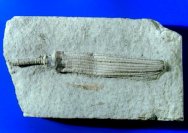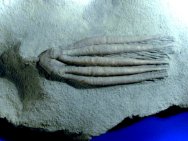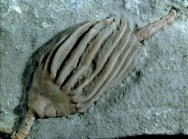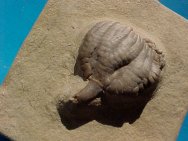Crawfordsville
Indiana Crinoid Fossils
|
|
|
|
|
|
Crawfordsville
Crinoids Structure Study: Cyathocrinites
iowensis (Family Cyathocrinidae - left) with
Platycrinites
saffordi stem (right); the stem served two
main functions: (1) placing the crown into the water column
to filter out food particles, and (2) anchoring the crinoid
in the substrate |
The
example of Agaricocrinus
americanus is exceptionally well preserved
in very three-dimensional relief, showing the fine pinnulation
needed to filter food from the water column |
| |
|
 |
|
Example
of the Camerate crinoid Macrocrinus
mundulus (Family Batocrinidae) with preserved
anal tube. This is another of the very 3-D preserved crinoids
for which the Crawfordsville deposits are well known. |
Well-preserved
example of an Inadunate crinoid Pachylocrinus
aequalis of Family Euspirocrinidae. This
is a fine example of the variety of diverse crinoids to
be found in the Crawfordsville deposits. |
A
fine example of an Inadunate Cladid crinoid (Family Scytalocrinidae)
known as Parascytalocrinus
validus from the famous Crawfordsville
crinoid beds. Preservation on this specimen is remarkably
complete, down to the fine pinnules on the arms. |
Remarkably
preserved Camerate crinoid from Family Staphylinocrinidae
known as Abrotocrinus
unicus from Crawfordsville. On the reverse is
a section of the fenestrate bryozoan Archimedes. |
|
|
|
|
Four
species - A museum quality example of an Inadunate Cladid
crinoid (Family Scytalocrinidae) known as Histocrinus
coreyi from the famous Crawfordsville crinoid
beds showing over 200 mm of attached stem complete with
attached cirri. Cirri found near the holdfast base were
used as additional anchors in the sea floor. This spectacular
crinoid is found in association with a fine Platycrinites
hemisphericus (Camerate crinoid, Family Platycrinitidae)
showing the characteristic spiral stem of the genus. The
smallest crinoid is a Scytalocrinus
robustus (Cladid, Family Scytalocrinidae).
Preservation on this specimen is remarkably complete,
down to the fine pinnules on the arms. They are found
in association with a fragment of the coral
Cladochonus beecheri. Crinoids like this
could be found in association because their differing
stem lengths allowed them each to feed in their own level
of the water column. |
A
fine example of an Inadunate Cladid crinoid (Family Blothocrinidae)
known as Ulrichicrinus coryphaeus
from the famous Crawfordsville crinoid beds. It is in
a fine state of preservation, with all the arms intact.
It is well centered on its 120 mm by 70 mm siltstone matrix. |
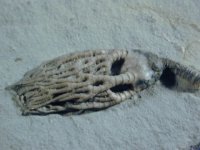 |
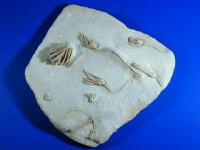
click pix to view details |
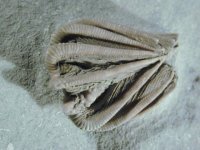 |
Museum
quality specimen of Inadunate crinoid Cyathocrinites
multibrachiatus |
|
Camerate
crinoid Agaricrinus splendens with 55
mm crown |
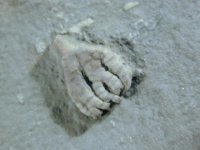 |
|
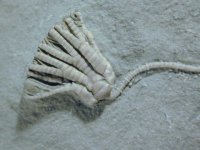 |
Flexible
crinoid Taxicrinus colletti with 10 mm
crown |
Onychocrinus
exculptus with Parascytalocrinus validus |
Rare
crinoid Sarocrinus varsourensis with
18 mm crown and long, 50 mm stem |
|
|
|
An
uncommon Inadunate Cladid crinoid Catillocrinus-tennesseeae,
of the Family Catillocrinidae. The generic name refers
to the location where the first one was collected;
crinoids
of this taxon are found in Tennessee, Kentucky, Iowa,
and Indiana. |
Two
examples of the Camerate crinoid Camptocrinus
(Family Dichocrinidae) appearing much as they are thought
to have been in life. They are believed to have lain at
the sea floor curled much as you see them here, unrolling
to filter feed when conditions were right. |
Inadunate
crinoid Parisocrinus labyrinthicus, Family
Euspirocrinidae |
| |
|
|
 |
Example
of the Camerate crinoid Macrocrinus
mundulus (Family Batocrinidae) that displays
the elongated anal tube. This is another of the very 3-D
preserved crinoids for which the Crawfordsville deposits
are well known. |
Well-preserved
and immactulately prepared example of the Inadunate Cladid
crinoid Barycrinus stellatus
(Family Barycrinidae), Note the exceptional preservation
in very three-dimensional relief. |
Well-preserved
and immactulately prepared example of a pair of Crawfordsville
crinoids. The larger example is Agaricocrinus
americanus (Family Coelocrinidae), while the
smaller is a Parisocrinus crawfordsvillenesis
(Family Euspirocinidae). Both crinoids show the fine
pinnulation needed to filter their food from the water
column. |
Description:
A well-preserved and meticulously prepared example of
a pair of Inadunate Cladid crinoids. The larger example
is Cyathocrinites harrodi
(Family Cyathocrinitidae), while the smaller is a Parisocrinus
crawfordsvillenesis (Family Euspirocinidae).
|
| |
|
|
|
A
fine example of an Inadunate Cladid crinoid (Family Scytalocrinidae)
known as Scytalocrinus decadactylus
from the famous Crawfordsville crinoid beds. Preservation
on this specimen is remarkably complete, down to the fine
pinnules on the arms. |
A
fine example of an Inadunate Cladid crinoid (Family Cyathocrinidae)
known as Saccosomopsis insperatus
from the famous Crawfordsville crinoid beds. Preservation
on this specimen is remarkably complete, down to the fine
pinnules on the arms. |
|
|











